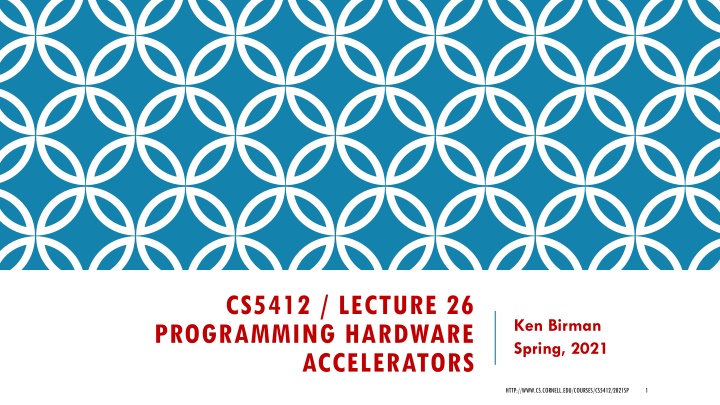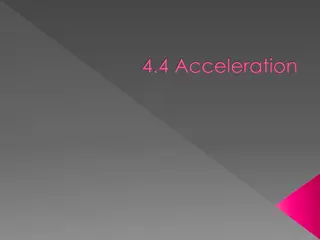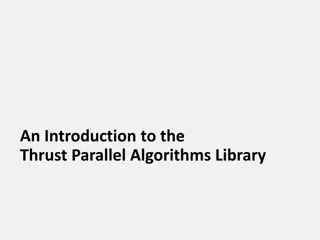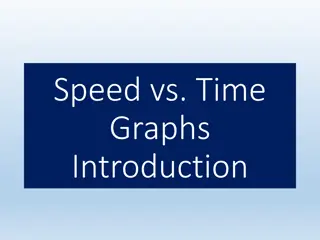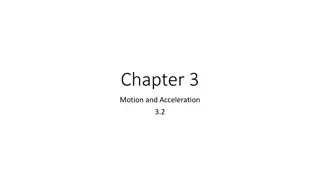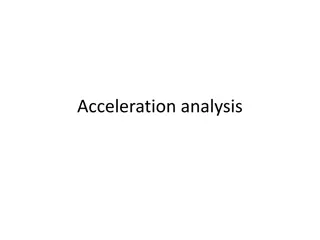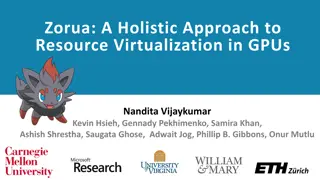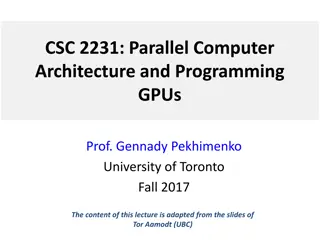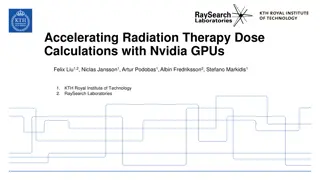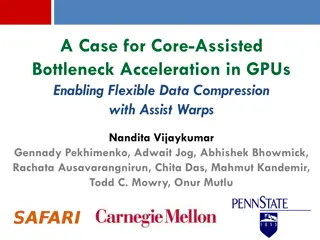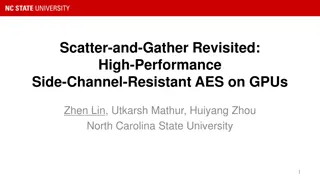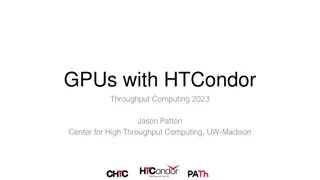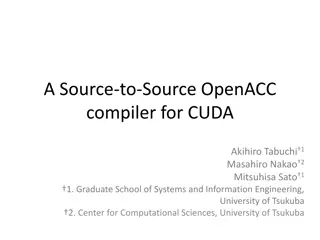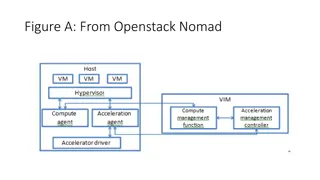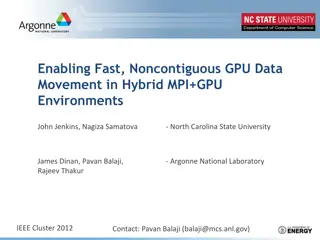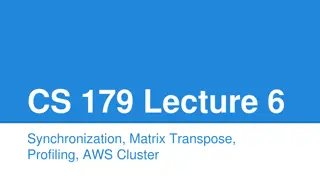Programming GPUs: How to Utilize CUDA for Acceleration
GPUs, like the NVIDIA Tesla T4, can be harnessed for high-performance computing by programming them with CUDA. This involves writing kernels that operate on data in GPU memory, leveraging the host computer for data transfer. By understanding the hardware properties and control flow, efficient GPU programming can be achieved to accelerate computational tasks.
Download Presentation

Please find below an Image/Link to download the presentation.
The content on the website is provided AS IS for your information and personal use only. It may not be sold, licensed, or shared on other websites without obtaining consent from the author.If you encounter any issues during the download, it is possible that the publisher has removed the file from their server.
You are allowed to download the files provided on this website for personal or commercial use, subject to the condition that they are used lawfully. All files are the property of their respective owners.
The content on the website is provided AS IS for your information and personal use only. It may not be sold, licensed, or shared on other websites without obtaining consent from the author.
E N D
Presentation Transcript
CS5412 / LECTURE 26 PROGRAMMING HARDWARE ACCELERATORS Ken Birman Spring, 2021 HTTP://WWW.CS.CORNELL.EDU/COURSES/CS5412/2021SP 1
SUPPOSE THAT YOU PURCHASE A GPU. HOW WOULD YOU PROGRAM IT? GPUs come with a collection of existing software libraries that mostly are coded in a language called CUDA. They implement kernels . They define functions that require pointers to the data objects, which should be downloaded into GPU memory ahead of time. Then the GPU leaves its result in GPU memory too. After the function finishes, you upload the result. HTTP://WWW.CS.CORNELL.EDU/COURSES/CS5412/2021SP 2
HARDWARE PROPERTIES A GPU accelerator is a special device, purchased from a company like NVIDIA, that is designed to live next to a host computer. For example, you might have a Dell T740 server (common in the cloud) and attach an NVIDIA Tesla T4 GPU accelerator to it (cutting edge). We say that the Dell server is the host for the NVIDA GPU. HTTP://WWW.CS.CORNELL.EDU/COURSES/CS5412/2021SP 3
HARDWARE PROPERTIES NVIDIA Tesla T4 plugs into the Dell T740 Dell T740, blade configuration (lives in a rack) HTTP://WWW.CS.CORNELL.EDU/COURSES/CS5412/2021SP 4
WHO CONTROLS WHAT? Software in the device driver for the Tesla T4 lives in the Dell T740 and controls the GPU accelerator. The host computer can load kernels into the GPU device. and can DMA transfer into or out of the GPU memory region. and can load parameters to the GPU functions, then press run . The GPU code will run, perform the task, and then interrupt the host. then the host can read the results out of the GPU memory area. HTTP://WWW.CS.CORNELL.EDU/COURSES/CS5412/2021SP 5
HERE WE SEE THE HOST ON THE RIGHT (CPU) AND THE GPU IS SHOWN ON THE LEFT HTTP://WWW.CS.CORNELL.EDU/COURSES/CS5412/2021SP 6
DEFINITION OF KERNEL The term simply means any function that runs on the GPU accelerator A GPU card is a full computer but typically lacks a real operating system. Instead, it only offers these functions, and moreover, all data movement in and out of the GPU is via the host doing DMA into or from GPU memory. The host manages the GPU memory so that the GPU itself sees preallocated memory regions and can start computing as soon as the host computer says go . (This differs from gaming, where data lives mostly in the host memory.) HTTP://WWW.CS.CORNELL.EDU/COURSES/CS5412/2021SP 7
CUDA LIBRARIES ARE VERY EXTENSIVE! Companies like NVIDIA have created huge libraries for the most common graphics tasks and for the most important machine learning algorithms. Yet they don t easily adapt if you have a variation on a standard method, or want to explore some completely new method. This raises a question: Can we make it easier to program new kernel? HTTP://WWW.CS.CORNELL.EDU/COURSES/CS5412/2021SP 8
WELL DIVE DOWN ON TWO PAPERS First, Dandelion, a Microsoft Research concept for programming a system in a high level language (C#) and then automatically mapping parts of the code into a GPU accelerator. The slide set we ll look at was used for their talk at ACM Symposium on Operating Systems (SOSP) in 2013. Dandelion builds on the same LINQ ideas we saw on April 9! HTTP://WWW.CS.CORNELL.EDU/COURSES/CS5412/2021SP 9
SECOND BUT SOMEWHAT SHALLOW DIVE Dahlia is a more recent approach to this same question. The work is occurring at Cornell: Adrian Sampson leads the project, and the slides are from a talk he gave last year. Dahlia is still under development, talk is a bit sketchy on details. HTTP://WWW.CS.CORNELL.EDU/COURSES/CS5412/2021SP 10
SUMMARY AND CONCLUSIONS It is much easier to just use existing libraries and kernels if you can! But if not, there is a growing range of software to help you program in a general language like C# or C++, then map your code automatically into a GPU device. You won t find these solutions for Python: They need to work with a language that has direct control of data layouts and representations. HTTP://WWW.CS.CORNELL.EDU/COURSES/CS5412/2021SP 11
